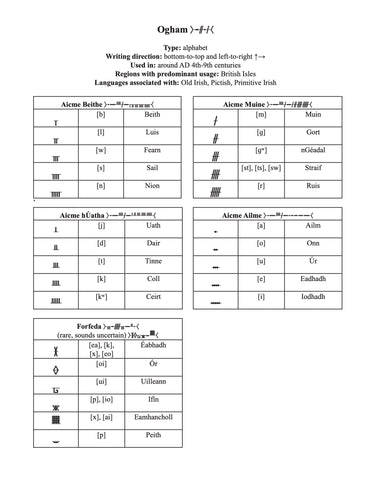Cracking the Code of the Ogham Script: Unraveling an Ancient Celtic Mystery

Script type: The Ogham script is a unique and ancient alphabet used for writing the early Irish language. It is categorized as an alphabet script, representing individual sounds rather than syllables.
Writing direction: The Ogham script is notable for its distinct writing direction. Unlike most scripts that are written horizontally, Ogham is written vertically, from bottom to top, along the edge of stones or wooden sticks.
Creator and invention time: The origins of the Ogham script are shrouded in mystery, and its exact creator remains unknown. Scholars believe that the script was invented by the early Celts, possibly around the 4th to 6th centuries CE.
Time period of use: The Ogham script was predominantly used during the early medieval period, between the 4th and 7th centuries CE. It was primarily employed in Ireland and parts of Western Britain.
Population and current usage: The Ogham script is no longer actively used for day-to-day writing and communication. However, it holds significant historical and cultural importance and is studied and appreciated by scholars, historians, and enthusiasts worldwide.
Usage area: Geographically, the Ogham script was used in regions where early Celtic languages were spoken, particularly in Ireland and parts of Western Britain.
Languages associated: The Ogham script was mainly used for writing the Old Irish language, which was spoken by the early Celtic inhabitants of Ireland and surrounding regions. It is one of the oldest known forms of written Irish.
Interesting Facts:
-
Notched Sticks and Stones: Ogham inscriptions were usually carved on stones or wooden sticks called "Ogham stones" or "Ogham sticks." Each character consists of one to five perpendicular lines or notches, making it a unique and visually striking writing system.
-
Mnemonic Aids: Ogham was more than just a writing system; it also served as a mnemonic device. Druids and scholars used it to record important information, such as genealogies, historical events, and even magic spells.
-
Regional Variations: The Ogham script had several regional variations, each with its own set of characters and rules. The two most common varieties are the Irish variant known as "Beith-Luis-Nin" and the British variant known as "Coelbren y Beirdd."
-
Hidden Meanings: Ogham inscriptions often carry deeper meanings and symbolism. Some inscriptions were used to mark graves, commemorate significant events, or serve as boundary markers.
-
Rediscovery and Revival: The Ogham script largely fell out of use with the decline of Old Irish as a spoken language. It experienced a resurgence of interest during the Celtic Revival in the 19th and early 20th centuries, as scholars and enthusiasts sought to preserve and revive ancient Celtic culture.
-
Decipherment Challenges: Deciphering the Ogham script presented a significant challenge for modern scholars. Its vertical orientation and unique notched characters made it a puzzle to be solved. However, with the combined efforts of linguists and historians, the script has been largely deciphered and understood.
-
Legacy and Heritage: The Ogham script remains an invaluable piece of Ireland's cultural heritage. Ogham stones and inscriptions serve as tangible links to the past, providing insight into the language, customs, and beliefs of early Celtic communities.
In conclusion, the Ogham script stands as a testament to the ingenuity and creativity of the ancient Celtic peoples. Through its unique writing direction and notched characters, it offers a glimpse into the rich cultural and linguistic history of Ireland and its Celtic roots. Though no longer actively used, the Ogham script continues to captivate and inspire, reminding us of the enduring power of writing systems to preserve and celebrate our shared human history.

Practice Ogham and other scripts with our book "100 Writing Systems of the World"!
Discover 100 diverse writing systems from around the globe in one captivating book. Practice writing different scripts with full character charts and essential information provided. Let your imagination soar on the blank right pages as you explore 43 abugidas, 33 alphabets, 14 abjads, 10 syllabaries, and 2 logographic scripts. Dive into numeral systems and even design your own writing system. Immerse yourself in the beauty and diversity of global scripts today with "100 Writing Systems of the World." Unleash your creativity and order now!